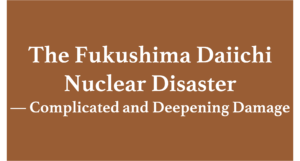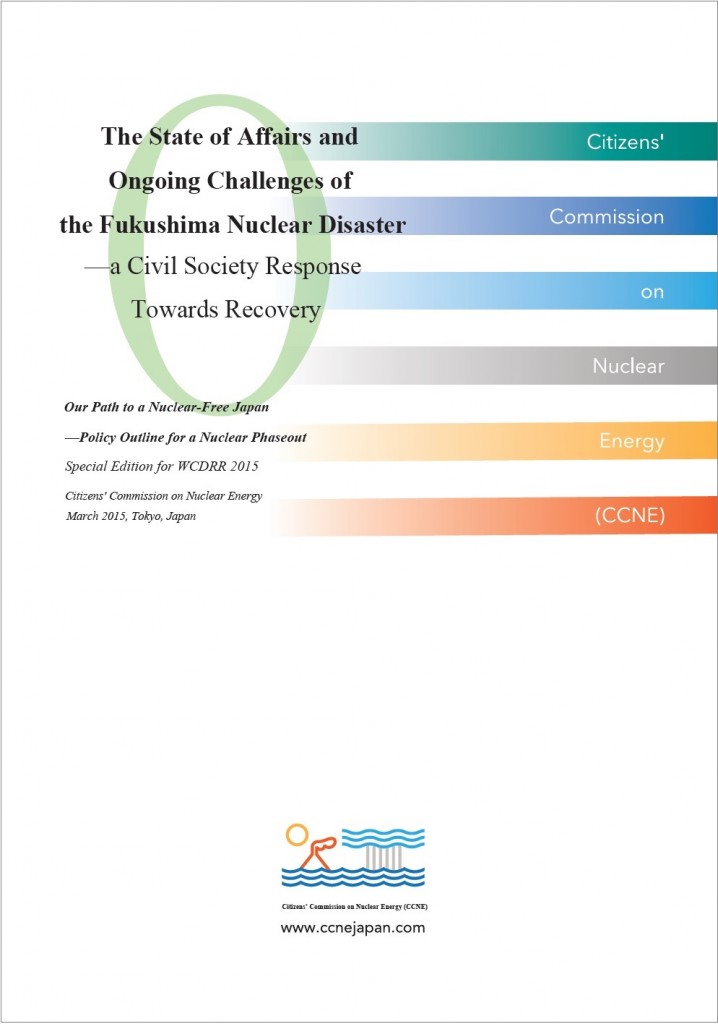The Long-term Strategy under the Paris Agreement Should
Take the Realization of a Nuclear-Free Society as its Premise
|
CCNE Statement:The Long-term Strategy under the Paris Agreement Should Take the Realization of a Nuclear-Free Society as its Premise |
28 June 2019 – on the occasion of G20 Osaka Summit
The Japanese goverment’s “Long-term Strategy under the Paris Agreement” (adopted by cabinet decision on June 11, 2019) has been formulated on the basis of the country’s 5th Strategic Energy Plan (2018) and additional recommendations of a government advisory panel. As a result, the “Strategy” is premised on the country’s obstinate policy of prolonged use of nuclear power, and thus carries over a huge pile of unsolved problems. The Japanese government, as the responsible host of G20 Osaka Summit, should face up to the serious problems of nuclear energy and promptly shift to a policy of nuclear phaseout. In accordance with such policy change, the national strategy should be thoroughly revamped to develop sustainable and socially healthy economy in Japan together with trade partners. Such strategy should include ambitious targets of renewable energy expansion and greenhouse gasses reduction to carry out Japan’s commitment to the Paris Agreement.
1. The government should face up squarely to the fundamental problems of nuclear power and should steer for a nuclear phaseout.
As an excuse that all options should be pursued, “The Long-term Strategy under the Paris Agreement” of Japan is unrealistically fixated on the preservation of nuclear power. Despite the fact that the government has declared that it will push forward with renewable energy as the major power source of the country, no ambitious mid- and long-term targets have been set, and the “Strategy” makes light of energy conservation and efficiency despite their significance in any sane energy policy. A number of defects have been pointed out in both the new nuclear regulatory standards, introduced after the Fukushima disaster, and the administration of the Nuclear Regulation Authority (NRA), a new regulator set up after Fukushima. With further problems such as deficiencies in the nuclear damages’ compensation scheme, dubious safety of the continued operation of aging reactors, and the hard question of how to dispose of nuclear waste, not only is nuclear power facing great difficulties, it has lost all economic rationality. If these fundamental issues are faced up to, it is clear that realization of a nuclear-free society is the only viable answer. The Japanese government has set the target of nuclear power in 2030 at 20 to 22% of total domestic power generation, but the achievement of this target is just unrealistic. In FY 2014, Japan’s total annual power generation by nuclear plants fell to zero, and in FY 2017 it was around 3% whilst solar power providing around 6% and all renewable energy providing around 16%. Of the 54 nuclear reactors operational prior to the Fukushima accident, only nine have been restarted thus far. In all major polls taken in Japan after Fukushima, consistently two-thirds of the respondents have opposed the restart of nuclear plants. This indicates that the revival plans and life extension plans of aging reactors, which are the two major means to attain the 20-22% target of nuclear power contribution to the national power supply, are practically infeasible in terms of public acceptance.
2.The new regulatory standards introduced in Japan after the Fukushima disaster cannot secure a safety of the nuclear plants.
Due to large numbers of lacunae and other loopholes, Japan’s new nuclear regulatory standards introduced after Fukushima is far from sufficient to secure plant safety. The regulations have even regressed in certain aspects, such as the retraction of the reactor siting guidelines that were applied prior to the Fukushima accident. The “Long-term Strategy”, while stating as future vision “Japan is reducing its dependency on nuclear energy as much as possible” (p.23), takes as its premise that nuclear plants certified by NRA as being compliant with what they call “the world’s strictest regulatory standards” shall be restarted. However, the ongoing compliance screening based on these problem-riddled post-Fukushima standards is gravely insufficient from the viewpoint of plant safety. Problems associated with responses to natural disasters such as earthquakes, tsunamis and volcanic activities also remain. Despite the fact that the reactor life was set in principle at 40 years, this has been gradually relaxed by NRA to the extent that an additional 20-year extension is often permitted, despite compelling safety questions in a number of aging plants in Japan. Furthermore, provisions are clearly inadequate against possible acts of terrorism aimed at nuclear facilities. There are also severe deficiencies in the national and local governments’ contingency planning and crisis management capabilities at times of nuclear accidents.
3.The real costs of nuclear power generation are high taking hidden costs and risks into full account.
As a power source, nuclear has never been cheap and can never contribute to the stable supply of electricity. Already over ten trillion yen ($93 billion) of the taxpayers’ money has been spent to support Tokyo Electric Power Co.(TEPCO), the utility liable to the Fukushima disaster’s compensation payments, and to decontamination and remediation work including the construction cost of an interim repository for gathered radioactive soil and other materials contaminated by the Fukushima fallout. Large amounts of tax money have also been spent to cope with the ongoing works at the accident site of Fukushima Daiichi, as well as the cost of administrative responses to the extensive social, economic and medical problems caused by the nuclear accident. Adding these sums together brings the total costs currently incurred for the Fukushima nuclear accident to more than 20 trillion yen ($186 billion). With a fresh awareness of this reality, the economics of nuclear power should be recalculated from scratch. The Japanese government is, however, attempting to prolong the life of uneconomical nuclear power while promoting electric power deregulation. This means that nuclear power, with its high costs and risks, will be unable to stand on its own two feet without governmental subsidies and all sorts of preferential treatment.
4.Extremely little effort has been made by the Japanese Government to reflect public opinions in the policy-making process so far.
Democratic processes are lacking in the formation of energy policy in Japan. That’s the reason why the unrealistic and irrational “energy-mix” compositions proposed by the Government go unchecked. In the current issue of the Paris Agreement strategy, discussions were held only in the closed-door sessions of an informal ministerial board, “Advisory Panel on the Long-term Growth Strategy under the Paris Agreement”. There was absolutely no democratic participation of citizens in the decision-making process of the official strategy in compliance with the Paris Agreement. Public comments were solicited by the Environment Ministry for a period of less than one month, and an almost complete failure to reflect comments submitted is obvious in the final “Strategy” document that came out. There is an urgent necessity in this country for an overall review of the deliberation processes of climate and energy policies, an issue deeply influencing the daily lives of the people worldwide.
email@ccnejapan.com
telfax +81 (0)3 3358 7064
c/o Takagi Foundation, 3F Arai Bdg, 4-15 Yotsuya Honshiocho,
Shinjuku 160-0003, TOKYO


